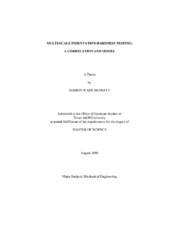| dc.description.abstract | This thesis presents the research results of a correlation and model based on nano
and macroindentation hardness measurements. The materials used to develop and test
the correlation include bulk tantalum and O1 tool steel. Following the literature review
and a detailed description of the experimental techniques, the results of the
nanoindentation hardness measurements are presented. After applying the methods and
correlation recommended here, the results should give an accurate value of hardness in
the Vickers scale for microstructural features that are too small to be precisely and
exclusively measured using the traditional macroindentation hardness technique. The
phenomena and influential factors in nanoindentation hardness testing are also discussed.
These phenomena and theories are consistent with the microstructural behavior predicted
in the Nix and Gao model for mechanism-based strain gradients. Implementing the
correlation factors and/or correlation curve, accurate results can be found for metals over
a broad hardness range. Initially, this research may impact the pipeline division of the
petroleum industry by providing a correlation to the Vickers scale for nanoindentation testing of microstructural features. This thesis may also provide a research methodology
to develop hardness correlations for materials other than metals.
This thesis consists of eight chapters. Following an introduction in Chapter I, the
research motivations and objectives are highlighted in Chapter II. Chapter III explains
the multi-scale indentation techniques used in this thesis and Chapter IV presents the
materials preparation techniques used. Then, the results are presented in Chapter V,
followed by the factors affecting nanoindentation hardness in Chapter VI. Finally,
Chapters VII and VIII reveal the indentation contact analysis, correlation, and
conclusions of this research, respectively. | en |


